child seat DODGE POWER WAGON 2007 2.G Owners Manual
[x] Cancel search | Manufacturer: DODGE, Model Year: 2007, Model line: POWER WAGON, Model: DODGE POWER WAGON 2007 2.GPages: 492, PDF Size: 8.25 MB
Page 11 of 492
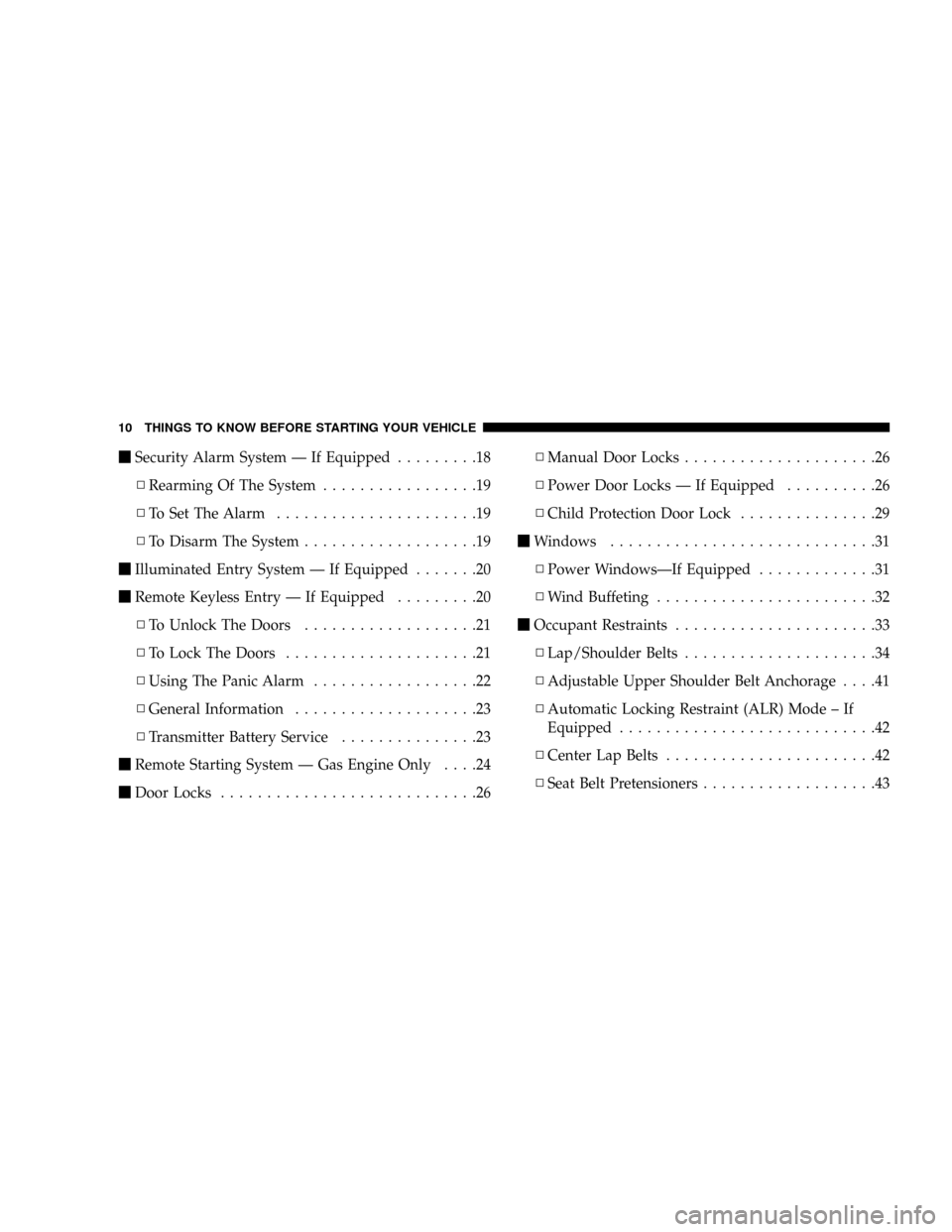
mSecurity Alarm System Ð If Equipped.........18
NRearming Of The System.................19
NTo Set The Alarm......................19
NTo Disarm The System...................19
mIlluminated Entry System Ð If Equipped.......20
mRemote Keyless Entry Ð If Equipped.........20
NTo Unlock The Doors...................21
NTo Lock The Doors.....................21
NUsing The Panic Alarm..................22
NGeneral Information....................23
NTransmitter Battery Service...............23
mRemote Starting System Ð Gas Engine Only....24
mDoor Locks............................26NManual Door Locks.....................26
NPower Door Locks Ð If Equipped..........26
NChild Protection Door Lock...............29
mWindows.............................31
NPower WindowsÐIf Equipped.............31
NWind Buffeting........................32
mOccupant Restraints......................33
NLap/Shoulder Belts.....................34
NAdjustable Upper Shoulder Belt Anchorage....41
NAutomatic Locking Restraint (ALR) Mode ± If
Equipped............................42
NCenter Lap Belts.......................42
NSeat Belt Pretensioners...................43
10 THINGS TO KNOW BEFORE STARTING YOUR VEHICLE
Page 12 of 492
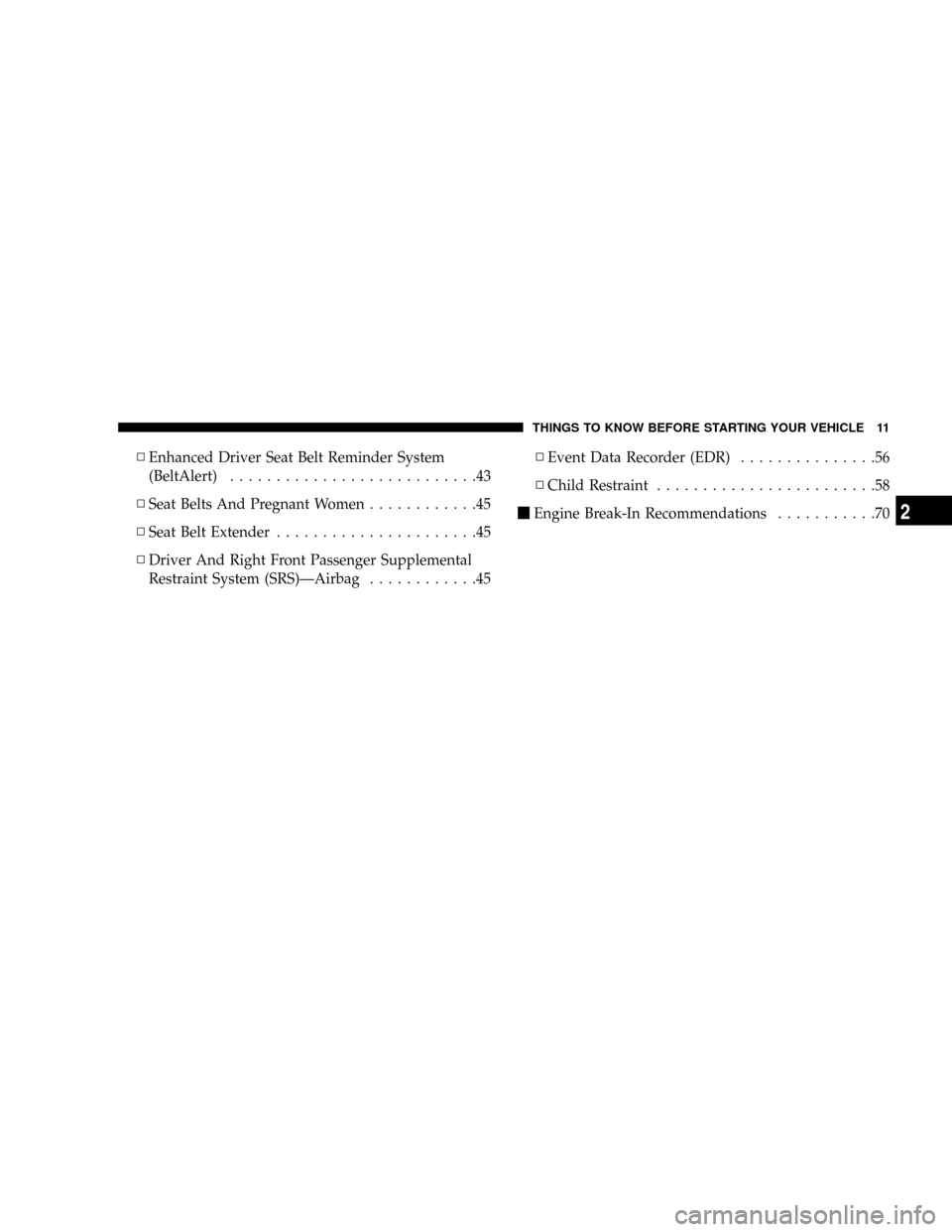
NEnhanced Driver Seat Belt Reminder System
(BeltAlert)...........................43
NSeat Belts And Pregnant Women............45
NSeat Belt Extender......................45
NDriver And Right Front Passenger Supplemental
Restraint System (SRS)ÐAirbag............45NEvent Data Recorder (EDR)...............56
NChild Restraint........................58
mEngine Break-In Recommendations...........70
THINGS TO KNOW BEFORE STARTING YOUR VEHICLE 11
2
Page 30 of 492
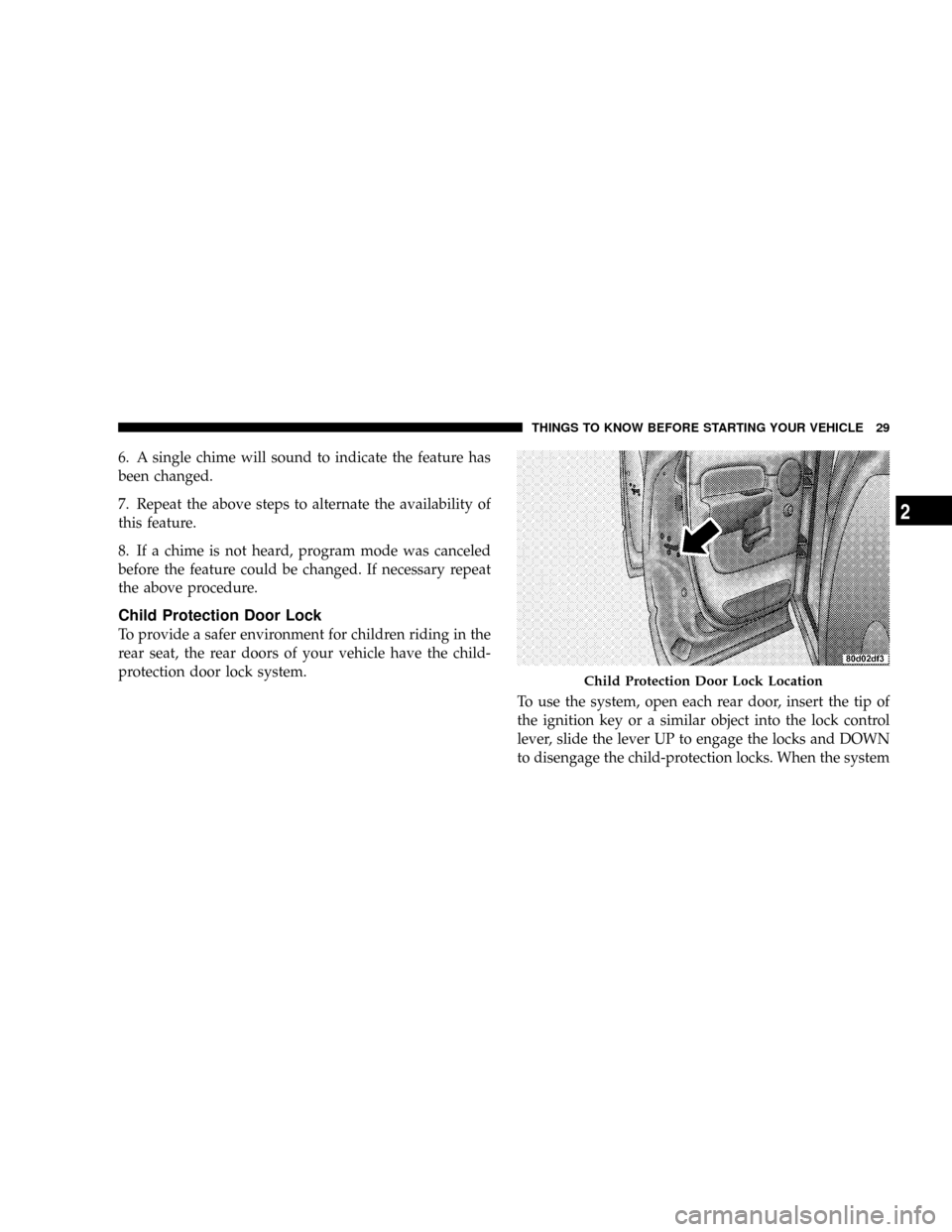
6. A single chime will sound to indicate the feature has
been changed.
7. Repeat the above steps to alternate the availability of
this feature.
8. If a chime is not heard, program mode was canceled
before the feature could be changed. If necessary repeat
the above procedure.
Child Protection Door Lock
To provide a safer environment for children riding in the
rear seat, the rear doors of your vehicle have the child-
protection door lock system.
To use the system, open each rear door, insert the tip of
the ignition key or a similar object into the lock control
lever, slide the lever UP to engage the locks and DOWN
to disengage the child-protection locks. When the system
Child Protection Door Lock Location
THINGS TO KNOW BEFORE STARTING YOUR VEHICLE 29
2
Page 34 of 492

occurs with the rear windows open, open the front and
rear windows together to minimize the buffeting.
OCCUPANT RESTRAINTS
Some of the most important safety features in your
vehicle are the restraint systems. These include the front
and rear seat belts for the driver and all passengers, front
airbags for both the driver and front passenger and, if so
equipped, window bags for the driver and passengers
seated next to a window. If you will be carrying children
too small for adult-size belts, your seat belts also can be
used to hold infant and child restraint systems.
Please pay close attention to the information in this
section. It tells you how to use your restraint system
properly to keep you and your passengers as safe as
possible.
WARNING!
In a collision, you and your passengers can suffer
much greater injuries if you are not properly buck-
led up. You can strike the interior of your vehicle or
other passengers, or you can be thrown out of the
vehicle. Always be sure you and others in your
vehicle are buckled up properly.
Buckle up even though you are an excellent driver, even
on short trips. Someone on the road may be a poor driver
and cause a collision that includes you. This can happen
far away from home or on your own street.
Research has shown that seat belts save lives, and that
they can reduce the seriousness of injuries in a collision.
Some of the worst injuries happen when people are
thrown from the vehicle. Seat belts reduce the possibility
THINGS TO KNOW BEFORE STARTING YOUR VEHICLE 33
2
Page 43 of 492
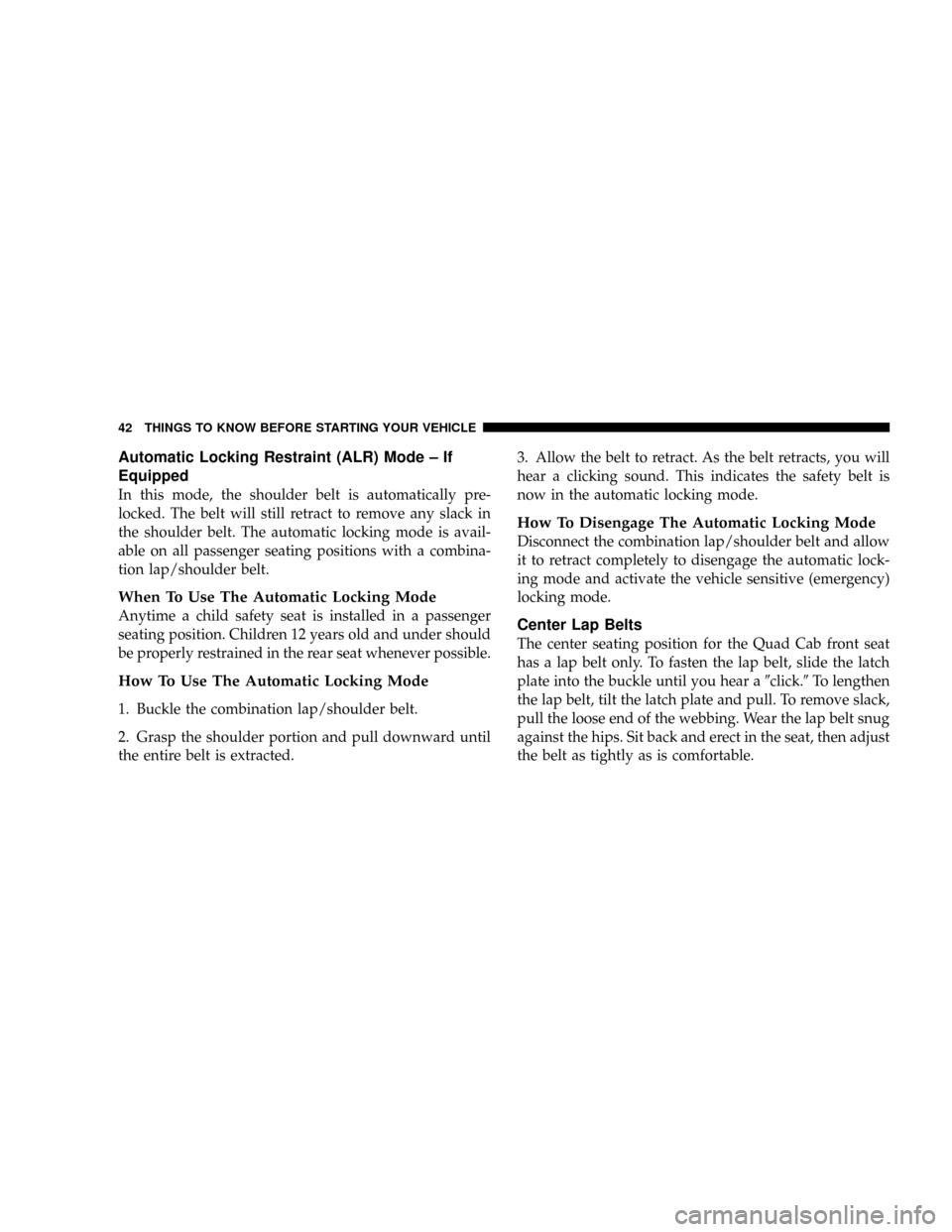
Automatic Locking Restraint (ALR) Mode ± If
Equipped
In this mode, the shoulder belt is automatically pre-
locked. The belt will still retract to remove any slack in
the shoulder belt. The automatic locking mode is avail-
able on all passenger seating positions with a combina-
tion lap/shoulder belt.
When To Use The Automatic Locking Mode
Anytime a child safety seat is installed in a passenger
seating position. Children 12 years old and under should
be properly restrained in the rear seat whenever possible.
How To Use The Automatic Locking Mode
1. Buckle the combination lap/shoulder belt.
2. Grasp the shoulder portion and pull downward until
the entire belt is extracted.3. Allow the belt to retract. As the belt retracts, you will
hear a clicking sound. This indicates the safety belt is
now in the automatic locking mode.
How To Disengage The Automatic Locking Mode
Disconnect the combination lap/shoulder belt and allow
it to retract completely to disengage the automatic lock-
ing mode and activate the vehicle sensitive (emergency)
locking mode.
Center Lap Belts
The center seating position for the Quad Cab front seat
has a lap belt only. To fasten the lap belt, slide the latch
plate into the buckle until you hear a9click.9To lengthen
the lap belt, tilt the latch plate and pull. To remove slack,
pull the loose end of the webbing. Wear the lap belt snug
against the hips. Sit back and erect in the seat, then adjust
the belt as tightly as is comfortable.
42 THINGS TO KNOW BEFORE STARTING YOUR VEHICLE
Page 44 of 492
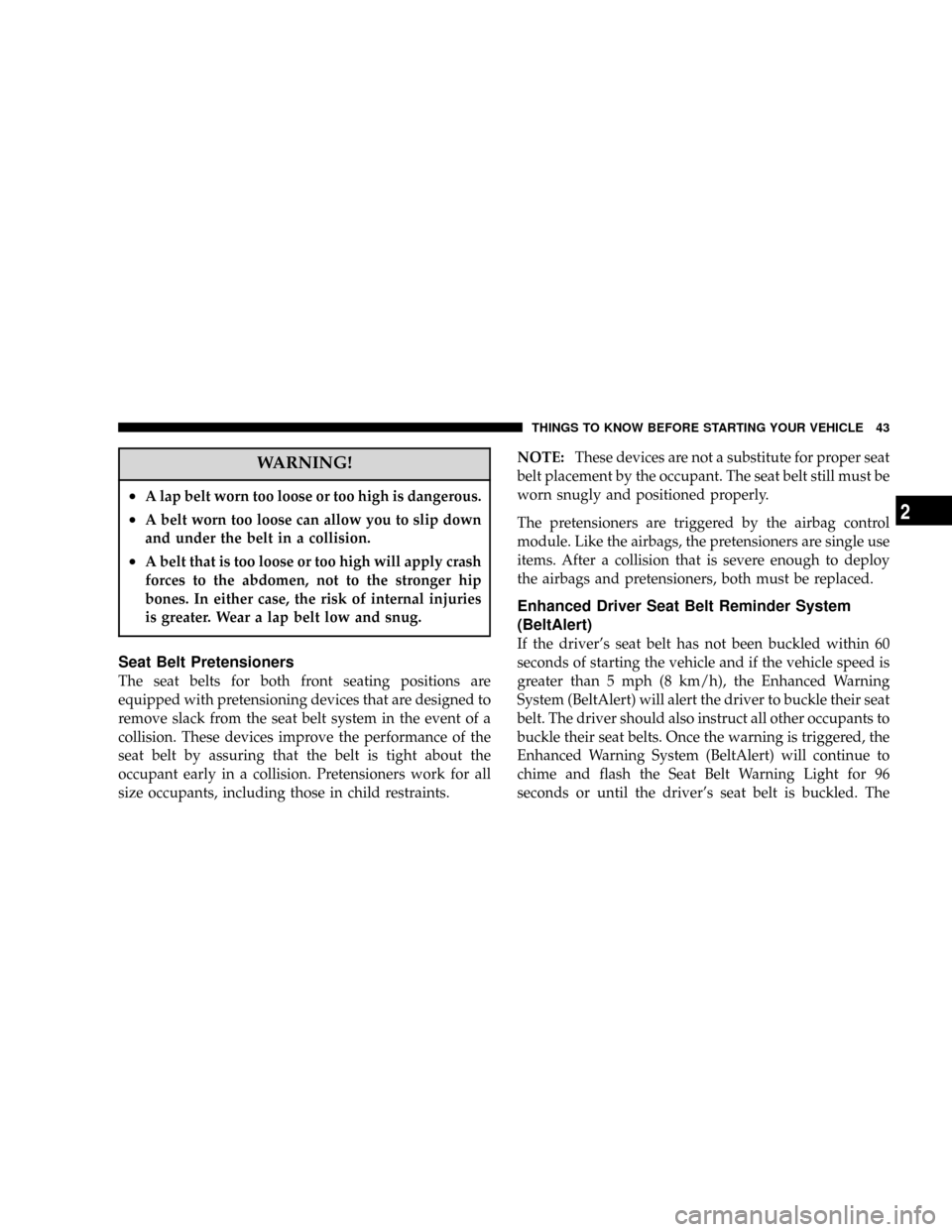
WARNING!
²A lap belt worn too loose or too high is dangerous.
²A belt worn too loose can allow you to slip down
and under the belt in a collision.
²A belt that is too loose or too high will apply crash
forces to the abdomen, not to the stronger hip
bones. In either case, the risk of internal injuries
is greater. Wear a lap belt low and snug.
Seat Belt Pretensioners
The seat belts for both front seating positions are
equipped with pretensioning devices that are designed to
remove slack from the seat belt system in the event of a
collision. These devices improve the performance of the
seat belt by assuring that the belt is tight about the
occupant early in a collision. Pretensioners work for all
size occupants, including those in child restraints.NOTE:These devices are not a substitute for proper seat
belt placement by the occupant. The seat belt still must be
worn snugly and positioned properly.
The pretensioners are triggered by the airbag control
module. Like the airbags, the pretensioners are single use
items. After a collision that is severe enough to deploy
the airbags and pretensioners, both must be replaced.
Enhanced Driver Seat Belt Reminder System
(BeltAlert)
If the driver's seat belt has not been buckled within 60
seconds of starting the vehicle and if the vehicle speed is
greater than 5 mph (8 km/h), the Enhanced Warning
System (BeltAlert) will alert the driver to buckle their seat
belt. The driver should also instruct all other occupants to
buckle their seat belts. Once the warning is triggered, the
Enhanced Warning System (BeltAlert) will continue to
chime and flash the Seat Belt Warning Light for 96
seconds or until the driver's seat belt is buckled. The
THINGS TO KNOW BEFORE STARTING YOUR VEHICLE 43
2
Page 48 of 492

NOTE:Do not use a clothing bar mounted to the coat
hooks in this vehicle. A clothing bar will impede the
proper performance of the window bags.
Airbags inflate in moderate to high speed impacts. Along
with the seatbelts, front airbags work with the instrument
panel knee bolsters to provide improved protection for
the driver and front passenger. Window bags also work
with seat belts to improve occupant protection.
The seat belts are designed to protect you in many types
of collisions. The front airbags deploy in moderate to
severe frontal collisions. If your vehicle is so equipped,
the window bag on the crash side of the vehicle is
triggered in moderate to severe side collisions. In certain
types of collisions, both the front and side airbags may be
triggered. But even in collisions where the airbags work,
you need the seat belts to keep you in the right position
for the airbags to protect you properly.Here are some simple steps you can follow to minimize
the risk of harm from a deploying airbag.
²Children 12 years and under should ride buckled up in
a rear seat, if available.
²Infants in rear facing child restraints mustNEVER
ride in the front seat of a vehicle with a passenger front
airbagunless the airbag is turned off(Standard Cab
Vehicles Only). An airbag deployment can cause se-
vere injury or death to infants in that position. See the
Passenger Airbag On/Off Switch section.
²If your vehicle does not have a rear seat, see the
Passenger Airbag On/Off Switch section.
²Children that are not big enough to properly wear the
vehicle seat belt (see section on Child Restraints)
should be secured in the rear seat in child restraints or
belt-positioning booster seats. Older children who do
not use child restraints or belt-positioning booster
THINGS TO KNOW BEFORE STARTING YOUR VEHICLE 47
2
Page 49 of 492

seats should ride properly buckled up in the rear seat.
Never allow children to slide the shoulder belt behind
them or under their arm.
²All occupants should use their seat belts properly.
²The driver and front passenger seats should be moved
back as far as practical to allow the airbag room to
inflate.
WARNING!
²Relying on the airbags alone could lead to more
severe injuries in a collision. The airbags work
with your seat belt to restrain you properly. In
some collisions the airbags won't deploy at all.
Always wear your seat belts even though you
have airbags.
²Being too close to the steering wheel or instru-
ment panel during airbag deployment could cause
serious injury. Airbags need room to inflate. Sit
back, comfortably extending your arms to reach
the steering wheel or instrument panel.
²If the vehicle has window airbags, they also need
room to inflate. Do not lean against the door or
window. Sit upright in the center of the seat.
48 THINGS TO KNOW BEFORE STARTING YOUR VEHICLE
Page 53 of 492

because the infant has a medical condition which
makes it necessary for the driver to be able to see the
infant,
²is a child, age 1 to 12 who must ride in the front seat
because there is no rear seat, because there is no rear
seat position available, or because the child has a
medical condition which makes it necessary for the
driver to be able to see the child,
²has a medical condition which makes passenger airbag
inflation (deployment) a greater risk for the passenger
than the risk of hitting the dashboard (instrument
panel) or windshield in a crash.
WARNING!
Whenever an airbag is turned off, even a lap/
shoulder belted passenger may hit their head, neck,
or chest on the dashboard (instrument panel) or
windshield in a crash. This may result in serious
injury or death.
To Shut Off the Passenger Airbag (Standard Cab Ve-
hicles Only)
Place the ignition key in the Passenger Airbag On/Off
Switch, push the key in and turn clockwise, and remove
the key from the switch. This will shut off the passenger
side airbag. The ªOffº light near the switch will illumi-
nate when the ignition switch is turned to the ON
position.
52 THINGS TO KNOW BEFORE STARTING YOUR VEHICLE
Page 56 of 492

bags to inflate, it signals the inflators on the crash side of
the vehicle. A quantity of nontoxic gas is generated to
inflate the window bag. The inflating window bag
pushes the side pillar molding out of the way and covers
the window. The airbag inflates in about 30 milliseconds
(about one-quarter of the time it takes to blink your eyes)
with enough force to injure you if you are not belted and
seated properly, or if items are positioned in the area
where the window bag inflates. This especially applies to
children. The window bag is only about 3
1¤2inches (8.9
cm) thick when it is inflated.
Enhanced Accident Response System
If the airbags deploy after an impact and the electrical
system remains functional, vehicles equipped with
power door locks will unlock automatically. In addition,
approximately 10 seconds after the vehicle has stopped
moving, the interior lights will light until the ignition
switch is turned off.
Maintaining Your Airbag Systems
WARNING!
²Modifications to any part of the airbag system
could cause it to fail when you need it. You could
be injured because the airbags are not there to
protect you. Do not modify the components or
wiring, including adding any kind of badges or
stickers to the steering wheel hub trim cover or
the upper right side of the instrument panel. Do
not modify the front bumper, vehicle body struc-
ture, or frame.
²You need proper knee impact protection in a
collision. Do not mount or locate any aftermarket
equipment on or behind the knee bolster.
²It is dangerous to try to repair any part of the
airbag system yourself. Be sure to tell anyone who
works on your vehicle that it has airbags.
THINGS TO KNOW BEFORE STARTING YOUR VEHICLE 55
2